Gigabyte H77N-WiFi Review – First Look at Ivy Bridge with mITX
by Ian Cutress on November 6, 2012 12:00 PM EST- Posted in
- Motherboards
- Gigabyte
- H77
- mITX
Rightmark Audio Analyzer 6.2.5
In part due to reader requests, we are pleased to include Rightmark Audio Analyzer results in our benchmark suite. The premise behind Rightmark:AA is to test the input and output of the audio system to determine noise levels, range, harmonic distortion, stereo crosstalk and so forth. Rightmark:AA should indicate how well the sound system is built and isolated from electrical interference (either internally or externally). For this test we connect the Line Out to the Line In using a short six inch 3.5mm to 3.5mm high-quality jack, turn the OS volume to 100%, and run the Rightmark default test suite at 48 kHz, 96 kHz and 192 kHz. The results are given both numerical ratings and word ratings from ‘Very Poor’ to ‘Excellent’. We grade this test by assigning each of the word ratings a value from 1-6, and the final result is the sum of these ratings, and the score should end up between 8 and 48.
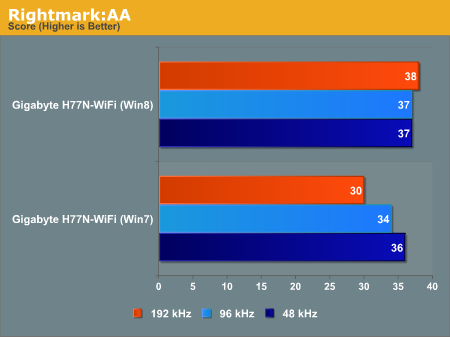
The Gigabyte board is our first motherboard on our test bed to go through Rightmark, so while we do not have any comparative numbers yet, but we can draw conclusions. In our testing, the Windows 7 performance rises with bit-rate, whereas the Windows 8 driver gives constant performance throughout. The dynamic range of the Realtek ALC892 is rated at 110 dBA ideal, but losses due to design come through – in this case the Gigabyte tops out at 86.2 dBA at 48 kHz.
USB Speed
For this benchmark, we run CrystalDiskMark to determine the ideal sequential read and write speeds for the USB port using our 240 GB OCZ Vertex3 SSD with a SATA 6 Gbps to USB 3.0 converter. Then we transfer a set size of files from the SSD to the USB drive using DiskBench, which monitors the time taken to transfer. The files transferred are a 1.52 GB set of 2867 files across 320 folders – 95% of these files are small typical website files, and the rest (90% of the size) are the videos used in the Sorenson Squeeze test.

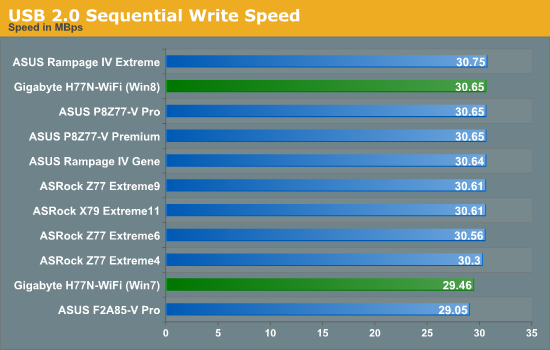
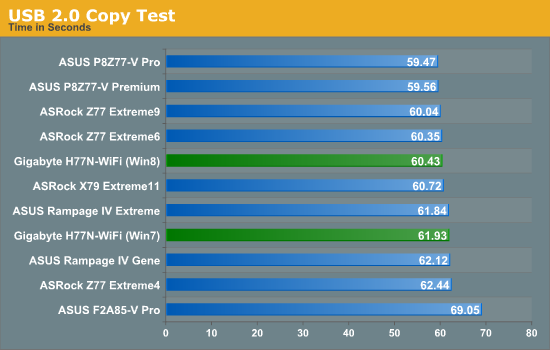

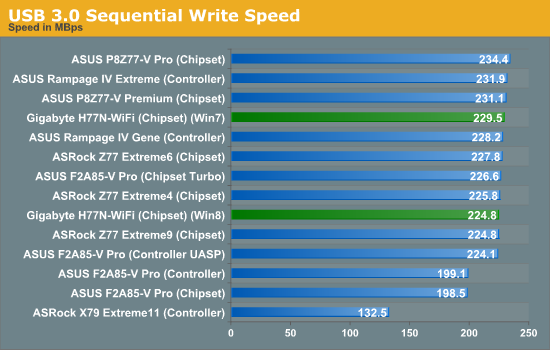

At some point in the future we will be adjusting our testing to Windows 8, which will be able to take advantage of the UASP protocol for USB 3.0 transfers. In our performance review of Windows 8 this manifested itself in an increase in sequential USB 3.0 read speed from 256.6 Mbps to 406.30 Mbps, which meant a 4% quicker USB copy test as writing was not similarly affected.
DPC Latency
Deferred Procedure Call latency is a way in which Windows handles interrupt servicing. In order to wait for a processor to acknowledge the request, the system will queue all interrupt requests by priority. Critical interrupts will be handled as soon as possible, whereas lesser priority requests, such as audio, will be further down the line. So if the audio device requires data, it will have to wait until the request is processed before the buffer is filled. If the device drivers of higher priority components in a system are poorly implemented, this can cause delays in request scheduling and process time, resulting in an empty audio buffer – this leads to characteristic audible pauses, pops and clicks. Having a bigger buffer and correctly implemented system drivers obviously helps in this regard. The DPC latency checker measures how much time is processing DPCs from driver invocation – the lower the value will result in better audio transfer at smaller buffer sizes. Results are measured in microseconds and taken as the peak latency while cycling through a series of short HD videos - under 500 microseconds usually gets the green light, but the lower the better.
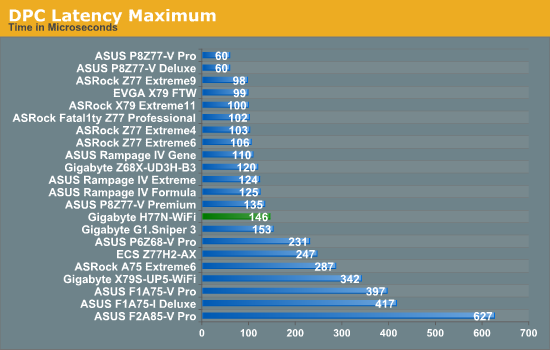
The DPC Latency test is starting to become one where we have two different types of motherboard manufacturer. The top tier manufacturers offer better software with their products, often with monitoring tools as part of the package in order to monitor overclocks or fan speeds. These monitoring tools inject high priority requests in the system on a regular basis (every 1-3 seconds), delaying other requests such as those for audio, causing spikes in DPC Latency which could lead to distortion or other audio anomalies. Surprisingly manufacturers without these tools do not have these issues. These issues are sometimes fixed via a BIOS update, but even if one board gets updated and fixed, it for some reason does not propagate to future products or the back catalogue. So here we are with the Gigabyte H77N-WiFi, which gives a good sub-200 microsecond result, but unfortunately while EasyTune6 is enabled, this can spike to 32000 microseconds. Ouch.










52 Comments
View All Comments
extide - Tuesday, November 6, 2012 - link
Seems like it would be more appropriate than using a 7970 or 580desiredusername145 - Wednesday, November 7, 2012 - link
C'mon Anandtech whats the point testing this with an i3???Now I wasted time even opening this article, shame on you
cjs150 - Wednesday, November 7, 2012 - link
"C'mon Anandtech whats the point testing this with an i3???"That is a bit harsh. I suspect lots of people will pair an i3 with a mini-itx board.
Personally I have an i7-3770T in my mini z77 board but lots of people would regard that as overkill (also runs a bit hot - I suspect the culprit is intel using cheap thermal paste on the IHS as widely reported).
HappyCracker - Wednesday, November 7, 2012 - link
Agreed. Even a Clarkdale i3 will happily push 1080p content to a 1080p display with its integrated graphics and I think this is where a lot of users will position their ITX boxes. As long as you're not in a huge hurry, you can also encode video. It's all about positioning the right computer in the right spot.hasseb64 - Wednesday, November 7, 2012 - link
mITX boards are more and more intresting, but I want you as a reviewer to focus more on power consumption.Th-z - Wednesday, November 7, 2012 - link
Is there going to be a review on APU (FM2) with mITX? I'm also looking for a prebuilder that sells APU mITX system using small chassis with external power supply. Puget has them using Antec ISK 110 and 310 cases, but you can only customize them for Intel parts.Last question, isn't it illogical to say "UEFI BIOS"? As UEFI is to replace BIOS, not an extension of BIOS, as "UEFI BIOS" would imply. The F in UEFI already stands for Firmware, so conceptually, it's like saying "Firmware BIOS". If wheel is to replace feet, we just need to call it wheel, not wheel feet.
Urbanos - Wednesday, November 7, 2012 - link
you didn't cover wireless! its a main feature of this mobo.missing all networking bench's, also does it allow for teaming? and how well?
did you test the raid setup? will each controller see each other's array in the config utility?
chassis options? temperatures?
dual HDMI tests and examples? image quality?
don't mean to be a dick here, but anandtech has a much higher standard than this.
klmccaughey - Wednesday, November 7, 2012 - link
We need you to spot the flaws before we buy it Ian, so I see no problem with you being critical as you are always constructive.Keep up the great reviews! I'm still waiting for my ITX HTPC killer board - they are all far to expensive.
rwpritchett - Wednesday, November 7, 2012 - link
Good review Ian. I've been running with this motherboard for about a month now in an ISK 310-150. It's good to see someone review the H77 version rather than the Z77.I'd like to add another gripe about the layout- the 24-pin power header. It's right on the top edge of the board. My case has fans on that side and the fan blades hit the clip on the power connector. If it was moved away from the edge just 2mm it would be in the clear (or better yet, it should be on the memory side of the motherboard like the Asus H77 ITX) . I had to forego a fan in that position for now, but I plan to add washers to slightly space a fan away from the 24-pin connector.
Another slight annoyance is that the BIOS refuses to see my SSD if the SATA is set to RAID. I don't know if it is specific to my model of SSD, a Crucial M4, or there is a bug that needs to be fixed.
cjs150 - Thursday, November 8, 2012 - link
Would the 24 pin position work for you ?I prefer the 24 pin to be at the edge of the board but at right angles to current position (ie not pointing straight up). Would be nice if someone would prefer a 90 degree 24 pin adapter